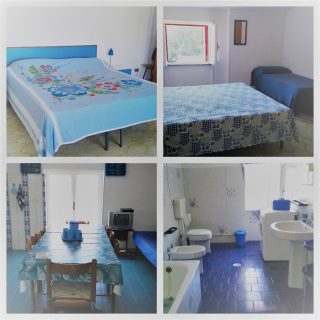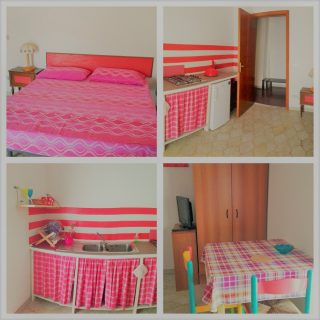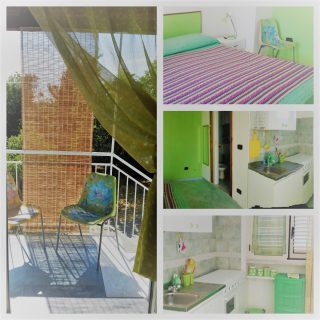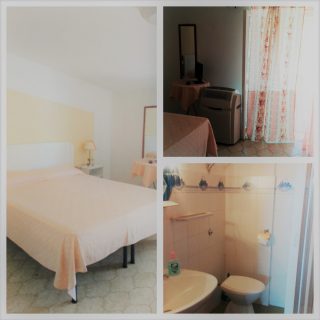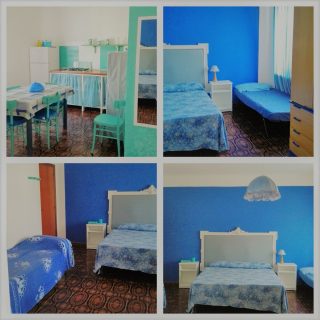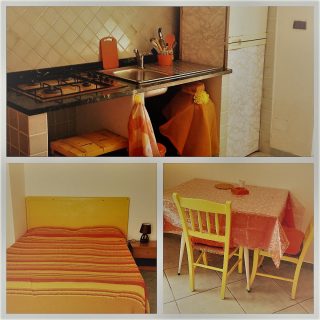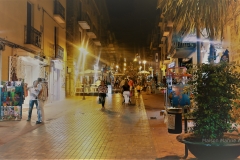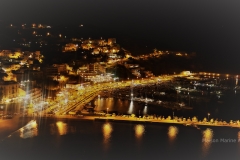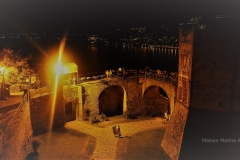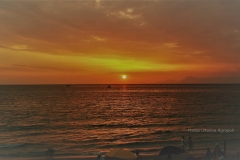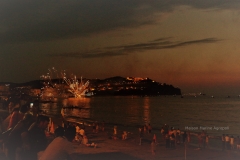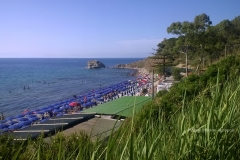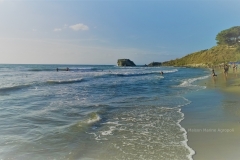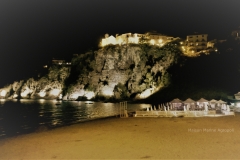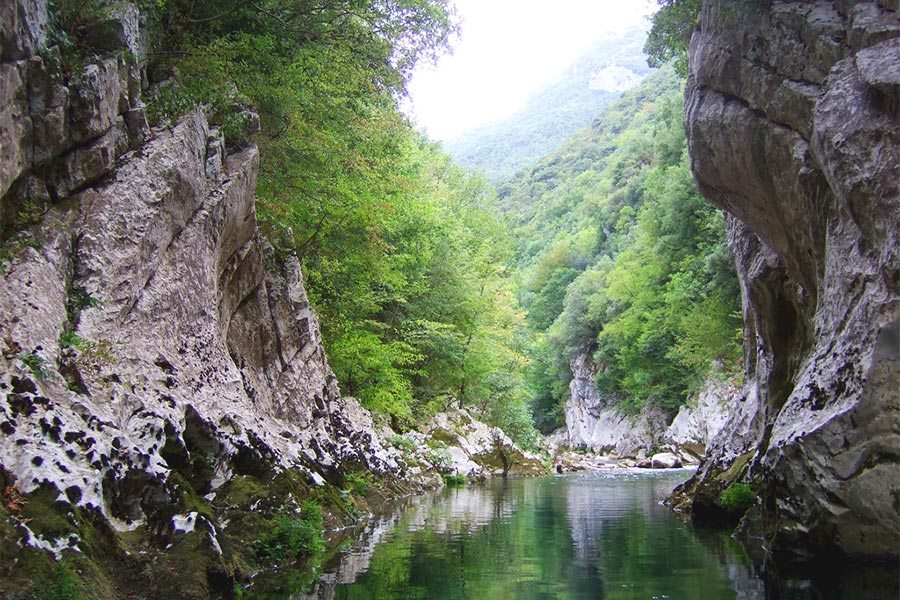
Cilento en
Cilento
Journey into the past: Paestum and Velia
From the 5th century BC on, two important centers of Greek culture were to be found on the Cilento coast: Poseidonia, later to become Paestum, and Elea, present-day Velia.
At Paestum you can visit three extremely well preserved Greek-Doric temples. It was only in 1968 that the “Tomb of the Diver” was discovered – its five frescoes bearing significant testimony to antique artistry.
This and other finds from the times of the Greeks and Romans are on display at the Archaeological Museum right next to the excavation sites. It counts among the most important museums of its kind in Italy.
Velia gained importance due to its famous school of philosophy, its main representatives being Parmenides and Xenon. Today, you can visit the remains of this town with its amphitheater and its town gate Porta Rosa.
UNESCO World Heritage Site: the Chartreuse of Padula
The late Baroque Carthusian monastery “Certosa di San Lorenzo” at Padula is the largest of its kind in Italy and it is one of the major ecclesiastical monuments of Italy. It has been listed as a UNESCO World Heritage Site since 1998.
On a total of 50,000 m² there is a lot to admire, above all from an architectural point of view; for example, the Baroque staircase spanning two floors or the cloister covering an area of 90 x 130 m. Today, the monastery attracts art lovers from all over the world. It houses the Museo Archeologico della Lucania Occidentale, which includes a large collection of paintings.
A visit to the small town of Padula with its medieval center and located above the chartreuse is also worthwhile.
Cilento maritime: Museo Vivo del Mare at Pioppi
The museum at Pioppi is one of the most popular museums in the Campania region. It is found in fascinating Palazzo Vinciprova, a historically significant building at Pioppi’s lungomare. It was built in the 17th century by the Ripolis, a family from Catalonia.
Today’s name Palazzo Vinciprova goes back to its last owners – family Vinciprova from Omignano. Under the leadership of G. Garibaldi, they took an active part in establishing an Italian state in the 19th century.
On the first floor of the museum, the underwater world of the Cilento coast is presented in a total of 12 aquaria. Some of the tanks are open, giving visitors the opportunity to touch the animals and plants.
The sea museum is also a first aid/rescue center for sea turtles, which are found more and more often at the Cilento coast.
On the second floor of the palazzo, there is a permanent exhibition on the topic of the Mediterranean Diet (Dieta Mediterranea). It is dedicated, above all, to the American dietician Ancel B. Keys, who lived and worked in the area for over 40 years. You can also have a look at Keys’ private library.
Opening hours: 10.30 – 12.30 h and 17.00 – 21.00 h; closed on Tuesdays
Entrance: 3 EUR / person
Guided tour: 1 EUR / person (in German and English)
Information under www.museovivodelmare.it
Culinary delights
The Cilento landscape is strongly defined by evergreen olive trees. If you want to, you can also take part in the autumn harvest. The mild olive oil is meanwhile produced with strict “D.O.C.” guarantee of quality, often it is also of organic quality. Good olive oil is offered, for example, at country estate Fasani, where products can be purchased in small quantities, or at the Cooperativa San Mauro Cilento, which also organizes Cilento evenings including degustation.
In the plain of Piana di Sele around Paestum it is the water buffaloes that really play the leading role. They provide the exclusive mozzarella di bufala. At country estates like Tenuta Vannulo or Barlotti, you can watch the impressively big but at the same time gentle animals at close range, try creamy and savoury mozzarella and watch the casari at work as they deftly pluck off pieces from the still warm loaf of cream cheese. Thus, the origin of the word mozzarella quickly becomes clear: ‘mozzare’ means ‘to pluck off’.
Wonders of nature upcountry
It is above all ‘inside’ the Cilento National Park that you find an abundance of geological attractions. Hiking through the lime stone massif you keep discovering spectacular crevices, enormous solution holes, waterfalls and impressive cave systems.
Grotte di Castelcivita
One of Italy’s largest cave systems is found between the Calore river and Monte Alburni. Grotte di Castelcivita is a fascinating underground world of innumerable corridors, chambers and fissures. If you are fit and sure-footed enough, you can advance into the cave for as far as 4 km. Stone tools and some bones estimated to be about 40,000 years old were found in the entrance area of the cave.
Opening hours:
March and Oct.: (admittance at) 10.30 h, 12 h, 13.30 h, 15 h
April – Sept.: (admittance at) 10.30 h, 12 h, 13.30 h, 15 h, 16.30 h, 18
Grotte di Pertosa
Unwinding for ca. 3 km the cave near the town of Pertosa is as impressive as well. To visit the cave you must first cross the Negro, an underground river, by boat. The beautiful stalagmite and stalactite formations, which wait to enchant you, often serve as an extraordinary setting for theater performances. At Pertosa, too, finds from the Bronze Age indicate early settlement of the area.
Opening hours:
March, Oct.: 10 – 17 h
April – May: 9 – 19 h
June – Aug.: 10 – 19 h
Sept.: 10 – 18 h
Closed on Mondays: Sept. 01st – March 31st
Oasi WWF Morigerati
Grotta del Bussento below the town of Morigerati has been a WWF oasis since 1995, thus enjoying special protection. An old mule trail takes you to the Bussento, which, after running several kilometers underground, ‘roars’ back to the surface here in a spectacular gorge. A beautiful circular hiking trail in the midst of lush vegetation runs through the ca. 600 ha area around the river and the grotto.
Opening hours:
March, Oct.: (admittance at)10.30 h, 12 h, 13.30 h, 15 h
April – Sept.: (admittance at)10.30 h, 12 h, 13.30 h, 15 h, 16.30 h, 18 h
Picturesque fishing villages and medieval mountain villages
However, the Cilento has more places of interest and beauty to offer: a lot of small fishing villages and medieval mountain towns, which awaken from their slumber only during the summer months, line the coast.
Acciaroli, the fishing village located on a cape, was visited several times by the author Ernest Hemingway, thus becoming quite well-known. Nowadays, it is not only known for its charming village center, but also for its especially good beach and water quality.
The picturesque town of Scario at the Gulf of Policastro has been chosen as a summer resort by well-to-do Romans and Neapolitans. Strolling along the lungomare you enjoy a fascinating panorama of the mountains and the sea of the southern Cilento and of the Maratea coast.
Marina di Camerota is inviting with its bustling activity, its beautiful harbor and promenade and its touch of the exotic: due to emigration and immigration, there’s a slight South American breeze throughout the alleyways. When this is celebrated every year in June, the Parrandeando festival turns the center into a large salsa stage.
Also brimful of life, Agropoli with its wonderful Old Town, which sits proudly on a rocky plateau above the sea. In summer, you should really stop by the small town. That’s when numerous events take place in the inner courtyard of Castello Aragonese, which is one of Agropoli’s landmarks.
The town of Palinuro owes its name to the helmsman from Virgil’s Aeneis who fell overboard while navigating around the cape and drowned. Today, fishermen take you safely to the grottos which are accessible only by boat and which can easily match their famous sister on Capri.
Located on a hill and listed as a UNESCO World Heritage Site, Castellabate appeals to you with its winding alleys and village palaces. The breathtaking view of the sea from the Belvedere is one of the settings in the movie “Benvenuti al Sud” (Welcome to the South).
Pisciotta with its romantic nooks and corners, its medieval center and authentic village life is equal in rank. Local life takes place, preferably, in Piazza Pinto between bar, alimentare and market stalls.
Camerota, which is located on a plateau, is also worth a visit.
Spectacular Costa di Maratea
Costa di Maratea holds a special position. Although Maratea belongs to the Basilicata region, many connoisseurs of Southern Italy regard this spectacular cliff line as the southern extension of the Cilento area.
Maratea Borgo wins you over with its Mediterranean small town charm. Standing 20 m high at the town’s feet and gazing out to sea, the Statue of Christ is a sight to see.
In the hinterland: authentic towns and abandoned villages
The untouched hinterland of the Cilento is worth the serpentine journey. Countless medieval towns, in which time seems to have stood still, fascinate visitors, e.g. Laurito, which is picturesquely situated on the slope of “Monte Fulgenti” and offers a beautiful panoramic view, San Mauro la Bruca, Rocca Cilento, Lentiscosa or Teggiano.
Due to a lack of prospects, many Cilentani felt and still feel impelled to leave their home country. San Severino is an example for a meanwhile forsaken medieval village and castle. Unfortunately, the place is meanwhile off limits to visitors. On your way down to Palinuro and Marina di Camerota, however, you can still catch a glimpse of it.


